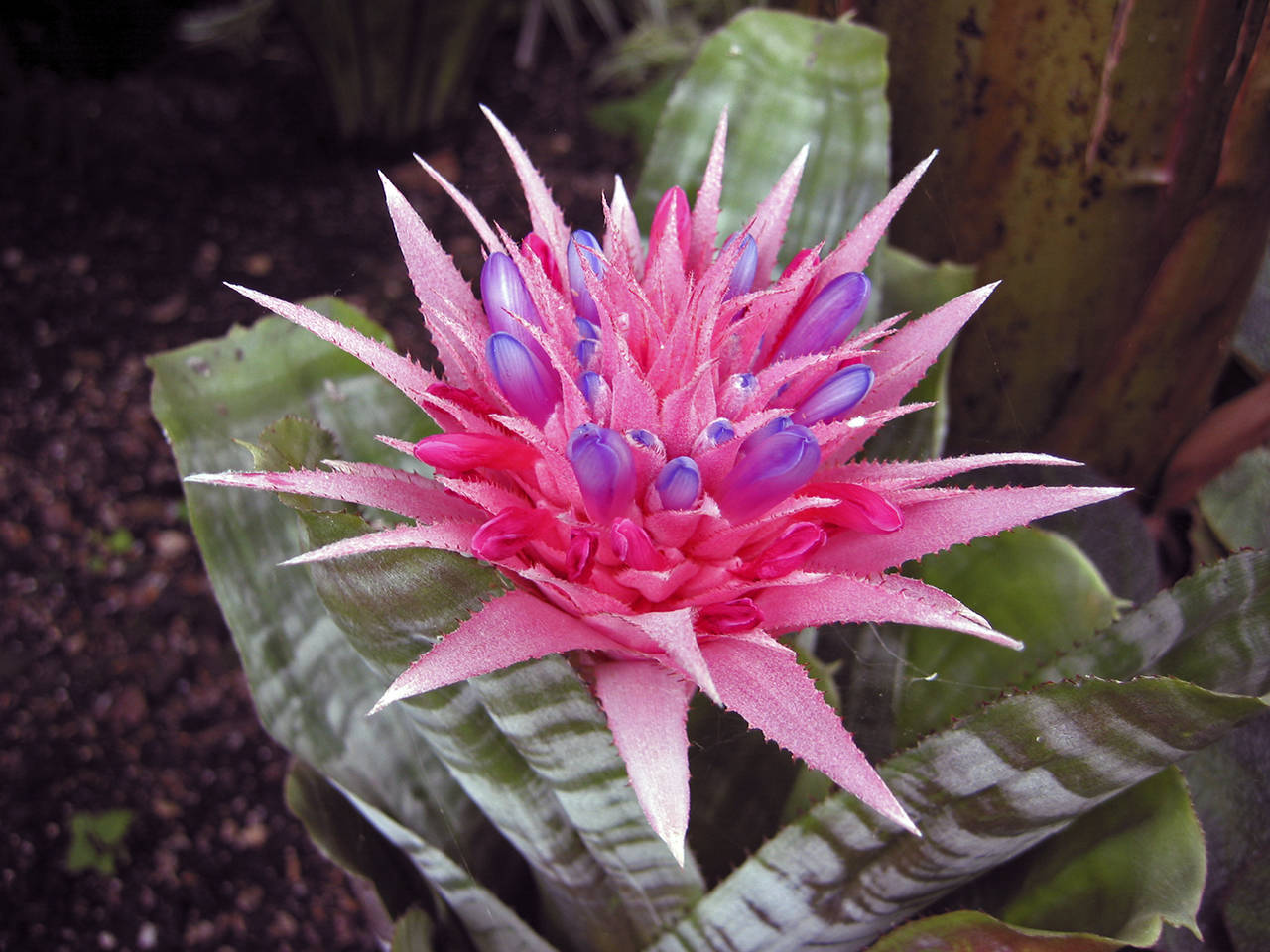By Dauna Koval
WSU Master Gardener
Pineapples are more than just tasty fruits; they also can be grown into unique houseplants.
When purchasing, select pineapples with attractive tops. Cut off the crown, leaving about an inch of fruit. Let dry a day or two. Use a planting medium of half lime-free potting soil and half peat moss. Plant the dried cutting, covering the fruit to the crown bottom. New plants aren’t too difficult to root, but at best it will take two or three years to flower and perhaps fruit.
Pineapples are of the Bromeliad family (genus: Ananas). They are tropical, succulent plants, needing more air humidity than fluid water. There are over 2,500 natural species with thousands more hybrids and cultivars. Bromeliads are monocots, related to grasses that utilize a form of photosynthesis that allows a more efficient use of water.
Many Bromeliads, like pineapples, are epiphytic — absorbing food and water through leaves rather than roots, and not needing soil for nutrition. Others are terrestrial, growing in soil and having more functional roots. Interestingly, many species can shift between the two types depending on their specific surroundings, making them ideal for variable house conditions and beginning gardeners.
Leaves of most species grow from the center, forming a rosette. Many have a vase-shaped cup (referred to as a “tank”) in the center that collects water from which the plant draws. Although Bromeliads also prefer their planting medium moistened, water them primarily by filling their tanks. Tap water is fine if it is not alkaline. Rainwater is also fine. But never use water that has been softened, because of the addition of sodium. Don’t use distilled water, either, as it will draw nutrients out of the plants.
Since Bromeliads are native to the tropics, they thrive best in 12 hours of light with day temperatures of 70 to 90 degrees. Most need night temperatures to drop about 10 degrees in order to maintain their type of photosynthesis and to produce their spectacular floral displays. They need lots of humid air circulation (humidity of 50% to 75%.)
Mature plants produce spectacular floral displays that can last for weeks or months. The flowers themselves are small and insignificant, but they are surrounded by colorful bracts (specialized leaves looking like petals) and collected onto spikes or stems called inflorescences.
Most plants will flower once and then die. Before doing so, they produce offsets, referred to as “pups.” When these have reached one-third the size of the parent, they can be separated and repotted. Keep the pups in lower light and more humidity until roots are well established. As with pineapples, you will have to wait at least a couple of years for a bloom.
Genus Tillandsia (the “air plant”) is also a Bromeliad. These are small, epiphytic plants with thin, often twisted or distorted leaves, covered with gray-green scales that help prevent the escape of water. Some produce inflorescences with pink, red or lavender bracts that can last up to a year. Many are fragrant. Available everywhere right now, inside glass ornaments or glued to wood pieces, these are truly the no-care houseplant. They need more water than misting, so drip water over then every two or three days, and that’s about it.
Genus Aechmea was one of the first widely available. Once called urn plants, these have a deep tank from which grows one 6- to 12-inch inflorescence with pink or red bracts often forming a reverse rosette. The small red, white or blue flowers die a few at a time, leaving the inflorescence to remain up to six months. Leaves are often variegated and on the grayer side. Treat as other Bromeliad houseplants at the lower temperatures.
Genus Neoregelia contains several terrestrial varieties that can be grown outdoors here in Grays Harbor. They do not produce colorful bracts nor spectacular inflorescences, but rather a mound of small white, blue or purple flowers within their tanks. They are grown for their leaves, which can be green, banded, striped, spotted or variegated. They quickly produce pups and can be used as a ground cover, adding a tropical flavor to landscapes.
Genus Vriesea contains varieties with handsome foliage and long-lasting flattened, swordlike inflorescences in reds and yellows. Many hybrids have been developed that are easy to care for and less particular about light, watering and humidity.
Dauna Koval is a Grays Harbor and Pacific Counties Master Gardener, Class of 2016. She recently moved permanently to Ocean Shores and is replenishing her houseplant population after losing several in the move.


